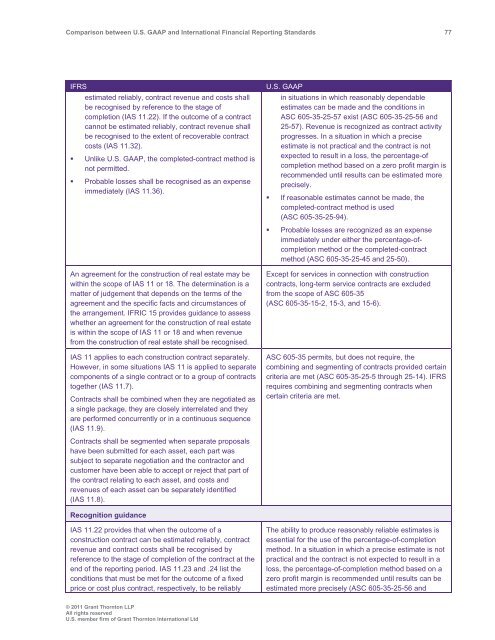Comparison between U.S. GAAP and International ... - Grant Thornton
Comparison between U.S. GAAP and International ... - Grant Thornton
Comparison between U.S. GAAP and International ... - Grant Thornton
You also want an ePaper? Increase the reach of your titles
YUMPU automatically turns print PDFs into web optimized ePapers that Google loves.
<strong>Comparison</strong> <strong>between</strong> U.S. <strong>GAAP</strong> <strong>and</strong> <strong>International</strong> Financial Reporting St<strong>and</strong>ards 77<br />
IFRS<br />
estimated reliably, contract revenue <strong>and</strong> costs shall<br />
be recognised by reference to the stage of<br />
completion (IAS 11.22). If the outcome of a contract<br />
cannot be estimated reliably, contract revenue shall<br />
be recognised to the extent of recoverable contract<br />
costs (IAS 11.32).<br />
• Unlike U.S. <strong>GAAP</strong>, the completed-contract method is<br />
not permitted.<br />
• Probable losses shall be recognised as an expense<br />
immediately (IAS 11.36).<br />
An agreement for the construction of real estate may be<br />
within the scope of IAS 11 or 18. The determination is a<br />
matter of judgement that depends on the terms of the<br />
agreement <strong>and</strong> the specific facts <strong>and</strong> circumstances of<br />
the arrangement. IFRIC 15 provides guidance to assess<br />
whether an agreement for the construction of real estate<br />
is within the scope of IAS 11 or 18 <strong>and</strong> when revenue<br />
from the construction of real estate shall be recognised.<br />
IAS 11 applies to each construction contract separately.<br />
However, in some situations IAS 11 is applied to separate<br />
components of a single contract or to a group of contracts<br />
together (IAS 11.7).<br />
Contracts shall be combined when they are negotiated as<br />
a single package, they are closely interrelated <strong>and</strong> they<br />
are performed concurrently or in a continuous sequence<br />
(IAS 11.9).<br />
Contracts shall be segmented when separate proposals<br />
have been submitted for each asset, each part was<br />
subject to separate negotiation <strong>and</strong> the contractor <strong>and</strong><br />
customer have been able to accept or reject that part of<br />
the contract relating to each asset, <strong>and</strong> costs <strong>and</strong><br />
revenues of each asset can be separately identified<br />
(IAS 11.8).<br />
U.S. <strong>GAAP</strong><br />
in situations in which reasonably dependable<br />
estimates can be made <strong>and</strong> the conditions in<br />
ASC 605-35-25-57 exist (ASC 605-35-25-56 <strong>and</strong><br />
25-57). Revenue is recognized as contract activity<br />
progresses. In a situation in which a precise<br />
estimate is not practical <strong>and</strong> the contract is not<br />
expected to result in a loss, the percentage-of<br />
completion method based on a zero profit margin is<br />
recommended until results can be estimated more<br />
precisely.<br />
• If reasonable estimates cannot be made, the<br />
completed-contract method is used<br />
(ASC 605-35-25-94).<br />
• Probable losses are recognized as an expense<br />
immediately under either the percentage-ofcompletion<br />
method or the completed-contract<br />
method (ASC 605-35-25-45 <strong>and</strong> 25-50).<br />
Except for services in connection with construction<br />
contracts, long-term service contracts are excluded<br />
from the scope of ASC 605-35<br />
(ASC 605-35-15-2, 15-3, <strong>and</strong> 15-6).<br />
ASC 605-35 permits, but does not require, the<br />
combining <strong>and</strong> segmenting of contracts provided certain<br />
criteria are met (ASC 605-35-25-5 through 25-14). IFRS<br />
requires combining <strong>and</strong> segmenting contracts when<br />
certain criteria are met.<br />
Recognition guidance<br />
IAS 11.22 provides that when the outcome of a<br />
construction contract can be estimated reliably, contract<br />
revenue <strong>and</strong> contract costs shall be recognised by<br />
reference to the stage of completion of the contract at the<br />
end of the reporting period. IAS 11.23 <strong>and</strong> .24 list the<br />
conditions that must be met for the outcome of a fixed<br />
price or cost plus contract, respectively, to be reliably<br />
The ability to produce reasonably reliable estimates is<br />
essential for the use of the percentage-of-completion<br />
method. In a situation in which a precise estimate is not<br />
practical <strong>and</strong> the contract is not expected to result in a<br />
loss, the percentage-of-completion method based on a<br />
zero profit margin is recommended until results can be<br />
estimated more precisely (ASC 605-35-25-56 <strong>and</strong><br />
© 2011 <strong>Grant</strong> <strong>Thornton</strong> LLP<br />
All rights reserved<br />
U.S. member firm of <strong>Grant</strong> <strong>Thornton</strong> <strong>International</strong> Ltd
















